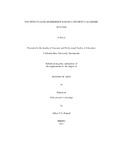- DSpace Home
- →
- Migrated Collections
- →
- Sacramento
- →
- zz-sac-migration
JavaScript is disabled for your browser. Some features of this site may not work without it.
| dc.contributor | Reveles, Francisco | en |
| dc.contributor.advisor | Dixon, Virginia | en |
| dc.contributor.author | Parnell, Albert V.G. | en |
| dc.date.accessioned | 2013-07-10T19:32:41Z | en |
| dc.date.available | 2013-07-10T19:32:41Z | en |
| dc.date.issued | 2013-07-10 | en |
| dc.date.submitted | 2013-05-09 | en |
| dc.identifier.uri | http://hdl.handle.net/10211.9/2125 | en |
| dc.description | Thesis (M.A., Education (Educational Leadership))--California State University, Sacramento, 2013. | en |
| dc.description.abstract | Gang membership in the United States is roughly 1 million (Johnson, 2009), and many of these gang members are enrolled in schools where teachers and administrators have to interact with the gang members on a daily basis. Some students in gangs go to class, study, and cause few to no problems. Others may do the exact opposite, skip school, misbehave in the classroom, portray aggressive behavior, steal and/or sell drugs. Although gang membership is prevalent, the direct impact that gang membership has on a student’s academic achievement has been vaguely touched upon. The goal of this study is to uncover what impact gang membership has on a student academic achievement; what forces drive a student to enter a gang; and what measures, policies, and programs have been implemented to prevent and intervene with students who are in gangs. Statement of Problem Gangs present a serious problem within a school, school district, and community. Not only do gangs and gang members affect the school they attend, they also affect the person who is in the gang. Many students in gangs are hindered academically because their focus is not on academics but is on their gangs, and their gang does not view education as a means to immediate success. Sources of Data The researcher interviewed two school board members, one parent with a child in middle school, an afterschool program coordinator, a K-12 school district police chief and two teachers. Conclusions Reached Through the study, the researcher has concluded gang membership has a negative impact on a student academic success. Moreover, gangs present problems inside and outside the school, thus causing problems within a student’s overall life outside the classroom. The researcher recommends an educational holistic approach that focuses more on ensuring that students understand the curriculum, instead of how well they do on standardized tests. Schools districts need to have teachers who can interact and understand different cultures, who are not judgmental of students, and who truly want to see the students succeed and become productive citizens. | en |
| dc.description.sponsorship | Graduate and Professional Studies in Education | en_US |
| dc.description.sponsorship | Graduate and Professional Studies in Education | en |
| dc.language.iso | en_US | en |
| dc.subject | Gang violence | en |
| dc.subject | School leadership | en |
| dc.subject | Gang prevention | en |
| dc.subject | K-12 education | en |
| dc.title | The effects gang membership has on a student's academic success | en |
| dc.type | Masters thesis | en |
Files in this item
The following license files are associated with this item:
This item appears in the following Collection(s)
-
zz-sac-migration [2]

